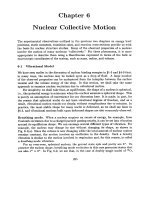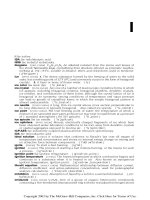Ebook Case-Based brain imaging (2nd edition): Part 2
Bạn đang xem bản rút gọn của tài liệu. Xem và tải ngay bản đầy đủ của tài liệu tại đây (17.89 MB, 280 trang )
Section IV
Neurodegenerative/
White Matter Diseases/
Metabolic
Tsiouris_CH85.indd 409
11/9/12 6:27 AM
Tsiouris_CH85.indd 410
11/9/12 6:27 AM
Case 85
Clinical Presentation
A 28-year-old woman presents with leg weakness.
Radiologic Findings
A,B
C
D,E
F
Fig. 85.1 Multiple axial T2-W FLAIR images demonstrate scattered periventricular foci of T2 prolongation
radiating from ventricles (A), within the left brachium
pontis (B), and within the splenium of the corpus callosum (C) in a pattern typical of demyelination as seen
with multiple sclerosis. The lesion within the corpus callosum demonstrates enhancement on the postcontrast
T1W image (D) and restricted diffusion on the DWI (E)
with matching ADC (F) signal consistent with an active
region of demyelination.
Diagnosis
Multiple sclerosis (MS)
Differential Diagnosis
•
•
•
•
Acutedisseminatedencephalomyelitis(morecommoninchildren,deepgraynuclearinvolvement
commonandcolossalinvolvementuncommon,indistinguishablefromfirstepisodeofMS)
Microvascularischemicdisease(olderpatient,typicallysparingofcorpuscallosumandsubcortical
Ufibers,lackofenhancement)
Vasculitis(smallchronicinfarctionsandleptomeningealenhancementmaybeseen)
Neoplasm(typicallymoremasseffect,rarelyinvolvesthecorpuscallosumunlessglioblastomaor
lymphoma)
411
Tsiouris_CH85.indd 411
11/9/12 6:27 AM
412
•
•
CASE-BASED BRAIN IMAGING
Neurosarcoidosis(mayseeleptomeningealenhancement,andthecorpuscallosumisnottypically
involved)
Progressivemultifocalleukoencephalopathy(corpuscallosumisnottypicallyinvolved—only2%ofwhite
matterdiseasesotherthanMSinvolvethecorpuscallosum,typicallyalsoinvolvesthesubcorticalUfibers)
Discussion
Background
MSisthemostcommonneurologicdisorderinyoungadults,generallyhavingonsetbetween20and45
yearsofage,although13%ofcasespresentbeforeage20and15%afterage50.MSismorecommonin
womenthanmenwitharatioof3:2.TheclinicaldefinitionofMSrequiresthatthepatientdemonstrate
evidenceoflesionsseparatedintimeandspace.Separationintimerequirestwoattackseachlasting
atleast24hoursinvolvingdifferentpartsoftheCNSandseparatedbyatleast1month.Separationin
spacerequiresclinicalevidenceofdistinctneurologicdeficitsand/orMRIevidenceofseparateCNSlesions.Pathologically,MSischaracterizedacutelybyinflammatorychangefollowedbymultifocalareas
ofdemyelinationwithvaryingdegreesofaxonaldegeneration.
Etiology
The cause is unknown, but it is likely an autoimmune reaction to an environmental stimulus in a
geneticallysusceptibleindividual.
Clinical Findings
Thepresentationvarieswiththelocationoflesions.Focalmotorandsensorydeficitsaretypical,with
headacheorseizuresbeinglesscommonpresentingsymptoms.Opticnerveinvolvementiscommon,
andpatientsmaypresentwithacutevisualchangesduetoopticneuritis.Spinalcordinvolvementmay
causemyelopathicsymptoms.Mostpatientshaveachronicrelapsingandremittingcourse,although
somepatientsmaydemonstratesteadyprogressionofdeficits.
TheMcDonaldCriteriaarediagnosticcriteriaforMS.Firstdefinedin2001,thecriteriawererevised
in2010toincludeobjectivecriteriatodemonstratedisseminationoflesionsintimeandspace.Criteria
includeclinicalandMRimagingfindings.
Complications
Blindness,paralysis,dementia,andlossofsphinctercontrolmaydevelopasthediseaseprogresses.
Clinical Subtypes
•
•
•
•
Relapsing-remitting(RR)isthemostcommoninitialpresentationofpatients(85%)
Secondary-progressive(SP)isconsideredtheusualprogressionofdiseasefromRR.By10years50%
ofRRandby25years90%ofRRpatientsenterSPphase.
Primary-progressive(PP):5–10%ofMSpatientsareprogressivefrominitialpresentation.
Progressive-relapsing(PR):rareprogressivediseasewithclearacuterelapses,withorwithoutfull
recovery.Periodsbetweenrelapsesarecharacterizedbycontinuingdiseaseprogression.
MS Variants
•
•
•
Tsiouris_CH85.indd 412
Marburg:youngerpatientstypicallypresentingwithfebrileprodromeandaclinicallyfulminant
course with death in months
Devictype:“neuromyelitisoptica”characterizedbydemyelinationoftheopticnervesandspinalcord
Schindlertype:“diffusesclerosis”characterizedbyextensive,confluent,asymmetricdemyelination
withinthebilateralsupratentorialand/orinfratentorialparenchyma
11/9/12 6:27 AM
IV NEURODEGENERATIVE/WHITE MATTER DISEASES/METABOLIC
•
413
Balo'sconcentricsclerosistype:characterizedbylargelesionswithalternatingzonesofdemyelinatedandmyelinatedwhitematter,monophasic,andoftenfatal
Pathology
Gross
•
•
Acuteplaquesareedematousandhaveapink-graycolor
Chronicplaquesshowatrophyandcysticchange
Microscopic
•
•
•
Thereisavariabledegreeofperivenularinflammation,macrophageinfiltration,myelinloss,edema,
andgliosis,withvaryingaxonalloss
Necrosis,hemorrhage,andcalcificationarerare
Cysticchangemayoccurinlargelesions
Imaging Findings
Computed Tomography
•
•
Lesionsaretypicallyisodenseorhypodenseonnoncontrastscan
Acutelesionsmayshowenhancementpostcontrast
Magnetic Resonance
•
•
•
•
•
•
•
•
LesionsaretypicallyhomogeneouslyhyperintenseonT2Wimaging.Largeacutelesionsmayhavea“target”appearance:ahyperintensecenterrepresentingdemyelinationwithaslightlylesshyperintenseperipheryrepresentingvasogenicedema.Arimofhypointensityseparatesthesetworegions.Whenlesions
arelargeandmasslikewithorwithoutedematheymaymimicneoplasm,tumefactiveMS(seeCase86).
Lesionsmaybeiso-orhypointenseonT1Wimaging,andmaydemonstratearimofT1shortening
attributedtofreeradicalsininfiltratingmacrophages.T1blackholesareMSplaqueswithdecreased
signalonT1.Ifacuteandenhancingthedecreasedsignalislikelyduetoedema.Chronicdecreased
signalwithinaplaqueonaT1Wimageisthoughttobesecondarytoassociatedaxonalloss.
Acutelesionsoftenenhancefollowinggadoliniumadministration,andthepatternmaybenodular,
arclike,orringlike.
Newdiseaseinflammationdisruptstheblood–brainbarrierresultinginenhancement.Enhancementmay
precedeT2abnormalities.Enhancementgenerallylasts4weeksandthenresolves(range1–16weeks).
Acute lesions may demonstrate diffusion restriction, or enlargement of preexisting T2 lesions
secondarytoacuteinflammation.
Lesionstypicallyaffectthecorpuscallosum,periventricularwhitematter,andarcuatefibers;theymay
alsooccurintheposteriorfossaandingraymatterstructuressuchasthebasalganglia.TheperiventricularWMlesionareoftenovoidandperpendiculartotheventricularsurface“Dawson’sfingers.”
Cerebralvolumelossgreaterthanexpectedforageisoftenseenanddiffuseorfocallossofvolume
ofthecorpuscallosummaybeseenduetointrinsiccorpuscallosumplaquesorduetoaxonalloss
secondarytomoreperipheralMSplaques.
MRspectroscopymaydemonstratereducedNAApeakswithareducedNAA:creatineratioandan
elevatedcholinewithinplaques.
Treatment
•
•
Tsiouris_CH85.indd 413
Corticosteroids,particularlyacutely
Beta-interferonandotherimmunomodulatorsarealsoused
11/9/12 6:27 AM
414
CASE-BASED BRAIN IMAGING
Prognosis
Highlyvariabledependingontheformofthediseaseanditsresponsivenesstotherapy
PEARLS
•
•
•
•
•
MR is much more sensitive and specific than CT for the diagnosis of MS, as MR’s multiplanar
capability better demonstrates callosal involvement and “Dawson’s fingers” (ovoid lesions with
theirlongaxisperpendiculartotheventricularsurface)(Fig. 85.2A, B).
GadoliniumadministrationisnotnecessaryforthediagnosisofMS.However,itdoesallowdifferentiationbetweenacuteandchroniclesions(onlyacutedemyelinationenhances)(Fig. 85.2C, D).
LesionsofMSgenerallylackmasseffectorsurroundingedemaevenwhenlarge
T2W imaging is more sensitive in evaluation of the posterior fossa for lesions than T2W FLAIR
(Fig. 85.2E, F)
AbnormalhypointensitymaybeseeninthebasalgangliainpatientswithseverelongstandingMS.
Thisisthoughttobeadegenerativephenomenonrelatedtoirondeposition.
PITFALLS
•
•
•
TumefactiveMSmaymimicabraintumororinfarction,butthereisgenerallylessmasseffectthan
wouldbeexpectedforasimilarlysizedtumor(Fig. 85.2G–I).OnCT,lesionsaretypicallyhypodense
comparedwithisodenseorhyperdenseinthecaseofcellulartumors.Additionally,thegiantplaquemay
showanasymmetric“front”ofenhancementratherthananintactringofenhancement(Fig. 85.2I).
WhenthedifferentialincludesbraintumorandtumefactiveMS,afollow-upscanmaybenecessary
toassessforevolutionandavoidanunnecessarybiopsy(Fig. 85.2J, K).MRspectroscopymayalso
aid in the diagnosis.
MRishighlysensitiveforthedetectionofMSlesions,butitisnonspecific.Therefore,findingsmust
becorrelatedwithotherclinicalparametersandlaboratoryfindingssuchasCSFanalysis.
Companion Cases
A,B
D
Tsiouris_CH85.indd 414
C
Fig. 85.2 (A–K) Examinations from multiple patients. The
typical MRI appearance of “Dawson’s fingers” is shown with
ovoid T2 hyperintense lesions radiating from the corpus
callosum on (A) axial and (B) sagittal T2W FLAIR. (C, D) The
second patient illustrates the use of contrast to identify acute
areas of inflammatory demyelination (D) in a patient with
severe underlying chronic disease on axial T2W FLAIR (C).
11/9/12 6:27 AM
IV NEURODEGENERATIVE/WHITE MATTER DISEASES/METABOLIC
415
E,F
G
H,I
J
Fig. 85.2 (continued) The third patient illustrates the increased conspicuity
of posterior fossa MS lesions on (F) T2W compared to T2W FLAIR images (E).
(G) The fourth patient presented with a hypodense lesion in the left parietal
lobe on CT. This tumefactive MS case can be distinguished from tumor by its
hypodensity on CT (compared to isodense or hyperdense in tumor), relative
lack of mass effect on surrounding brain that would be expected for tumor
on (H) axial T2W FLAIR and (I) irregular rim of enhancement on postcontrast
T1W imaging. (J, K) Same patient as in Fig. 85.2H, I. In patients where it is
unclear if the lesion in tumefactive MS or tumor, follow-up imaging may be
obtained. Four months after treatment with steroids (and also after biopsy)
(J) axial T2W FLAIR demonstrates decreased size of the lesion and nearly
complete resolution of enhancement on (K) postcontrast T1W imaging.
K
Suggested Readings
FoxRJ,RudickRA.Multiplesclerosis:diseasemarkersaccelerateprogress.LancetNeurol2004;3(1):10
Gean-MartonAD,VezinaLG,MartonKI,etal.Abnormalcorpuscallosum:asensitiveandspecificindicatorofmultiple
sclerosis.Radiology1991;180(1):215–221
MullinsME.Emergentneuroimagingofintracranialinfection/inflammation.RadiolClinNorthAm2011;49(1):47–62
PolmanCH,ReingoldSC,BanwellB,etal.Diagnosticcriteriaformultiplesclerosis:2010revisionstotheMcDonaldcriteria.
AnnNeurol2011;69(2):292–302
SajjaBR,WolinskyJS,NarayanaPA.Protonmagneticresonancespectroscopyinmultiplesclerosis.NeuroimagingClinN
Am2009;19(1):45–58
Tsiouris_CH85.indd 415
11/9/12 6:27 AM
Case 86
Clinical Presentation
A 28-year-old woman presents with generalized weakness.
Radiologic Findings
A,B
C
D,E
F
Fig. 86.1 (A) Axial CT demonstrates a hypodense lesion within the left posterior parietal white matter. Axial
(B, C) and sagittal (E) T2-FLAIR sequences demonstrate
two dominant rounded T2 hyperintense white matter
lesions within the left parietal lobe; these lesions demonstrate surrounding more pronounced T2 prolongation suggesting vasogenic edema. Lesions have minimal
local mass effect and mildly efface the regional sulci.
The sagittal T2-FLAIR sequence (E) also demonstrates a
lamellated, or onion-skin, appearance of the more anterior lesion. (D) Axial and (F) sagittal postcontrast T1W
images demonstrate ringlike enhancement of these
lesions. A tiny contralateral periatrial white matter lesion
does not enhance (C).
416
Tsiouris_CH86.indd 416
11/9/12 6:28 AM
IV NEURODEGENERATIVE/WHITE MATTER DISEASES/METABOLIC
417
Diagnosis
Tumefactive multiple sclerosis (MS)
Differential Diagnosis
•
•
•
•
•
•
Neoplasm(typicallymoremasseffect,moresurroundingvasogenicedema,raretohavelamellated
appearance,raretobehypodenseonCT)
Abscess (typically restricted diffusion centrally within the rim enhancing lesion, T2 hypointense
rim with “shaggy” enhancement)
Acutedisseminatedencephalomyelitis(morecommoninchildren,deepgraynuclearinvolvementcommonandcolossalinvolvementuncommon,butmaybeindistinguishablefromthefirstepisodeofMS)
Vasculitis(areasofinfarctionandleptomeningealenhancementarecommon)
Encephalitis(patientsaretypicallyacutelyillwithfeverandalterationinconsciousness)
Progressivemultifocalleukoencephalopathy(corpuscallosumisnottypicallyinvolved—only2%of
whitematterdiseasesotherthanMSinvolvethecorpuscallosum,typicallyalsoinvolvesthesubcorticalUfibers)
Discussion
Background
MSisthemostcommonneurologicdisorderinyoungadults,generallyhavingonsetbetween20and
45yearsofage,although13%ofcasespresentbeforeage20and15%afterage50.MSismorecommon
inwomenthanmenwitharatioof3:2.TheclinicaldefinitionofMSrequiresthatthepatientdemonstrateevidenceoflesionsseparatedintimeandspace.Separationintimerequirestwoattackseach
lastingatleast24hoursinvolvingdifferentpartsoftheCNSandseparatedbyatleast1month.Separationinspacerequiresclinicalevidenceofdistinctneurologicdeficitsand/orMRimagingevidenceof
separateCNSlesions.Pathologically,MSisadiseaseofoligodendrogliaandresultsinmultifocalareas
of well-demarcated demyelination with or without axonal degeneration.
Etiology
Thecauseisunknown,butitislikelyanautoimmunereactioningeneticallysusceptibleindividuals.
Clinical Findings
Thepresentationvarieswiththelocationoflesions.Focalmotorandsensorydeficitsaretypical,with
headacheorseizuresbeinglesscommonpresentingsymptoms.Opticnerveinvolvementiscommon,
and patients may present with acute visual changes due to optic neuritis. Spinal cord involvement may
causemyelopathicsymptoms.Mostpatientshaveachronicrelapsingandremittingcourse,although
somepatientsmaydemonstratesteadyprogressionofdeficits.
Complications
Blindness,paralysis,dementia,andlossofsphinctercontrolmaydevelopasthediseaseprogresses.
Clinical Subtypes
•
•
Tsiouris_CH86.indd 417
Relapsing-remitting(RR)isthemostcommoninitialpresentationofpatients(85%)
Secondary-progressive(SP)isconsideredtheusualprogressionofdiseasefromRR.By10years50%
ofRRandby25years90%ofRRpatientsenterSPphase.
11/9/12 6:28 AM
418
•
•
CASE-BASED BRAIN IMAGING
Primary-progressive(PP):5–10%ofMSpatientsareprogressivefrominitialpresentation
Progressive-relapsing(PR):rareprogressivediseasewithclearacuterelapses,withorwithoutfull
recovery.Periodsbetweenrelapsesarecharacterizedbycontinuingdiseaseprogression.
MS Variants
•
•
•
•
Marburg:youngerpatientstypicallypresentingwithfebrileprodromeandaclinicallyfulminant
course with death in months
Neuromyelitisoptica(NMO):characterizedbysimultaneousdemyelinationoftheopticnervesand
spinal cord; Devic type
Schindlertype:“diffusesclerosis”characterizedbyextensive,confluent,asymmetricdemyelination
withinbilateralsupratentorialand/orinfratentorialparenchyma
Balotype:“concentricsclerosis”characterizedbylargelesionswithalternatingzonesofdemyelinatedandmyelinatedwhitematter,monophasicandoftenfatal
Pathology
Gross
•
•
Acuteplaquesareedematousandhaveapink-graycolor
Chronicplaquesshowatrophyandcysticchange
Microscopic
•
•
•
Thereisavariabledegreeofperivenularinflammation,macrophageinfiltration,myelinloss,edema,
andgliosis,withrelativesparingofaxons
Necrosis,hemorrhage,andcalcificationarerare
Cysticchangemayoccurinlargelesions
Imaging Findings
Computed Tomography
•
•
Lesionsaretypicallyisodenseorhypodenseonnoncontrastscan
Lesionsmayshowenhancementpostcontrast
Magnetic Resonance
•
•
•
•
•
•
Tsiouris_CH86.indd 418
TumefactiveMSlesionsaretypicallylargeandhyperintenseonT2Wimaging.Lesionsmayhavea
“target,”“onion-skin,”orlamellatedappearance:ahyperintensecenterrepresentingdemyelination
with a slightly less hyperintense periphery representing vasogenic edema. A rim of hypointensity
separates these two regions.
Lesionsmaybeiso-orhypointenseonT1Wimaging,andmaydemonstratearimofT1shortening
attributedtofreeradicalsininfiltratingmacrophages
Lesions often enhance following gadolinium administration, and the pattern may be nodular,
arclike,orringlike.Incompleteringishelpfulindistinguishingthelesionfromneoplasm.
Enhancementgenerallylasts1to2monthsandthenresolves
AdditionalsmallerlesionsmoretypicalofMSmayleadtodiagnosis
Susceptibility-weighted images show normal undisrupted venules within the brain crossing the
plaques(Fig. 86.2D),whichislesslikelytobeseenwithneoplasms
11/9/12 6:28 AM
IV NEURODEGENERATIVE/WHITE MATTER DISEASES/METABOLIC
419
A
B
C
D
Fig. 86.2 Multiple sclerosis. Multifocal large confluent lesions demonstrating T2-hyperintensity (A), T1hypointensity (B), and heterogeneous enhancement (C)
in the periventricular white matter bilaterally. (D) The
susceptibility-weighted image demonstrates the normal
periventricular white matter venules (arrows) crossing
through these confluent active MS plaques, a finding not
usually seen with brain neoplasms.
Treatment
•
•
Corticosteroidsareamainstayoftherapy
Beta-interferonimmunomodulatorsarealsoconsideredmainstayoftherapy
Prognosis
Highlyvariabledependingontheformofthediseaseanditsresponsivenesstotherapy.
PEARLS
•
Tsiouris_CH86.indd 419
MRissignificantlymoresensitiveandspecificthanCTforthediagnosisofMS;MR’smultiplanar
capability better demonstrates callosal involvement and “Dawson’s fingers” (ovoid lesions with
their long axis perpendicular to the ventricular surface)
11/9/12 6:28 AM
420
CASE-BASED BRAIN IMAGING
A
Fig. 86.3 A 2-month follow-up MRI of the index
patient in Fig. 86.1 after 2 months of treatment.
Tumefactive MS can frequently mimic tumor, presenting with mass lesions demonstrating T2 prolongation
•
•
•
B
and enhancement (Fig. 86.1A-F), but these lesions have
markedly decreased in size and enhancement as demonstrated on the (A) axial T2-FLAIR and (B) postcontrast
T1W images.
GadoliniumenhancementpatternmayhelpdifferentiatetumefactiveMSfromneoplasm.Although
theenhancementpatternmaybenodular,asymmetric,orringlike,incompleteorasymmetricringof
enhancementdemonstratingthefrontofactivedemyelinationismorespecificfortumefactiveMS.
TumefactiveMSgenerallyhasminimalsurroundingvasogenicedema,andminimalregionalmass
effectcomparedwithsimilarsizedneoplasms,infarction,orabscess.
WhenthedifferentialincludesbraintumorandtumefactiveMS,afollow-upscanmaybeveryhelpfultoassessforevolutionandavoidunnecessarybiopsy(Fig. 86.3A,B).
PITFALLS
•
•
TumefactiveMSmaymimicabraintumororinfarction,butthereisgenerallylessmasseffectthan
wouldbeexpectedforasimilarlysizedtumor.Additionally,thegiantplaquemayshowanasymmetric “front” of enhancement rather than an intact ring of enhancement.
MR is highly sensitive for the detection of MS lesions, but it is nonspecific. Therefore, imaging
findingsmustbecorrelatedwithclinicalfindingsand,inparticular,acarefulpastclinicalhistory.
Suggested Readings
FoxRJ,RudickRA.Multiplesclerosis:diseasemarkersaccelerateprogress.LancetNeurol2004;3(1):10
Gean-MartonAD,VezinaLG,MartonKI,etal.Abnormalcorpuscallosum:asensitiveandspecificindicatorofmultiple
sclerosis.Radiology1991;180(1):215–221
MullinsME.Emergentneuroimagingofintracranialinfection/inflammation.RadiolClinNorthAm2011;49(1):47–62
SajjaBR,WolinskyJS,NarayanaPA.Protonmagneticresonancespectroscopyinmultiplesclerosis.NeuroimagingClinN
Am2009;19(1):45–58
Tsiouris_CH86.indd 420
11/9/12 6:28 AM
Case 87
Clinical Presentation
A 32-year-old woman presents with progressively worsening mental status, left lower extremity
weakness, and encephalopathy.
Radiologic Findings
B
A
D
C
Fig. 87.1 (A, B) Axial T2W FLAIR images demonstrate
multiple large and confluent T2 hyperintense white matter lesions with minimal associated enhancement (C). (D)
The dominant portions of the lesions show decreased
diffusivity on the apparent diffusion coefficient map
(bright on DWI images [not shown]).
421
Tsiouris_CH87.indd 421
11/9/12 6:35 AM
422
CASE-BASED BRAIN IMAGING
Diagnosis
Acute disseminated encephalomyelitis (ADEM)
Differential Diagnosis
•
•
•
•
Multiplesclerosis(MS)(generallyalessacutepresentation,notmonophasic)
Vasculitis(usuallypresentswithgrayandwhitematterinfarctions)
Viralencephalitis(maybeindistinguishable,butoftenmoregraymatterinvolvement)
Lymedisease(mayhavehistoryoftickexposurewithacharacteristicrash,mayhaveassociated
cranial nerve enhancement)
Discussion
Background
ADEMisademyelinatingdiseaseofprobableautoimmuneetiologybeginningasperivenularinflammationandprogressingtodemyelination.Itgenerallyhasanabruptclinicalonset1to3weeksfollowing
a viral illness or vaccination and runs a monophasic course. ADEM is more common in children than
inadults.Insomecases,itmayoccurintheabsenceofanidentifiableantecedentevent.Becauseofits
sensitivitytowhitematterpathology,MRhassignificantlyfacilitatedthediagnosisofthiscondition,
particularlyonT2WFLAIRimaging.
Etiology
The presumed pathogenetic mechanism is an immune-mediated reaction against CNS myelin triggeredbyviralinfectionorvaccination.Viralparticlesarenotusuallyisolatedfromthenervoussystem
ofADEMpatients,rulingoutadirectpathogenicrole.Manyviruseshavebeenimplicated,including
measles,rubella,varicellazoster,mumps,influenza,parainfluenza,andEpstein-Barr.
Clinical Findings
Clinicalpresentationandlaboratoryevaluationarevariableandnonspecific.Headache,meningismus,
fever,irritability,anddrowsinessarecommon.Seizuresandfocalneurologicdeficitsmayoccur.Cranial
nervedeficitsandspinalcordsymptomsmayalsooccur.CSFexaminationoftenshowsanonspecific
lymphocytic pleocytosis and elevated protein.
Complications
Severecasesmayprogresstostupor,coma,anddeath.Ahemorrhagicformexiststhatmaybecomplicatedbyparenchymalhematoma.
Pathology
Gross
•
•
•
Multifocallesionsofthewhitematterofthecerebrum,cerebellum,brainstem,andspinalcord
Lesionsmaybefoundinthegraymatteraswell,butarelessextensive
Petechialhemorrhagesmaybepresent
Microscopic
•
•
Tsiouris_CH87.indd 422
Perivenularlymphocyticandmonocyticinfiltrationanddemyelination
Lossofmyelinwithrelativesparingofaxoncylinders
11/9/12 6:35 AM
IV NEURODEGENERATIVE/WHITE MATTER DISEASES/METABOLIC
423
Imaging Findings
Computed Tomography
•
Asymmetricareasoflowdensityinthewhitemattermaybeseen
Magnetic Resonance
•
•
•
•
•
•
PatchybilateralasymmetricareasofT2prolongationinthesubcorticalanddeepwhitematterofthe
cerebralhemispheresrangingfrompunctatelesionstomasslike.Lesionsarecommoninthecerebellumandbrainstem,anddeepgraymatterinvolvementisalsocommon,especiallyinchildren.
Mayseehemorrhagesuperimposedonareasofdemyelination
Lesionsmayoccasionallyshowcentralcavitation
Postgadolinium,thereisvariableenhancementofthelesionswithapatternthatmaybenodular,
peripheral,ordiffuse.
Diffusionisvariableandmaybereducedinacutelesions.Reduceddiffusionmayindicatepermanent tissue injury.
MRspectroscopydemonstratesdecreasedNAA,increasedcholineandlactate.NAAcannormalize
with resolution of symptoms.
Treatment
•
Immunomodulatorytherapywithsteroids,intravenousimmunoglobulin,andplasmapheresis.
Prognosis
Highlyvariablerangingfrom50–60% of patients fully recovering in one month, 30% with neurologic
sequelae(commonlyseizure),andmortalityin10–30%
PEARLS
•
•
Imagingfindingsoftenlagbehindclinicalfindings
MonophasicillnessisthekeydifferentiatorfromMS
A,B
C
Fig. 87.2 Follow-up imaging after treatment for patient in
Fig. 87.1. (A, B) Follow-up axial T2W FLAIR images following
immunomodulatory therapy demonstrate a dramatic
Tsiouris_CH87.indd 423
decrease in the size and number of the white matter lesions.
(C) Some of the lesions developed intrinsic T1 shortening
after treatment which can be seen with remyelination.
11/9/12 6:35 AM
424
CASE-BASED BRAIN IMAGING
Suggested Readings
Axer H, Ragoschke-Schumm A, Böttcher J, Fitzek C, Witte OW, Isenmann S. Initial DWI and ADC imaging may predict
outcome in acute disseminated encephalomyelitis: report of two cases of brain stem encephalitis. J Neurol Neurosurg
Psychiatry2005;76(7):996–998
Mader I, Wolff M, Nägele T, Niemann G, Grodd W, Küker W. MRI and proton MR spectroscopy in acute disseminated
encephalomyelitis.ChildsNervSyst2005;21(7):566–572
PavoneP,Pettoello-MantovanoM,LePiraA,etal.Acutedisseminatedencephalomyelitis:along-termprospectivestudy
andmeta-analysis.Neuropediatrics2010;41(6):246–255
Tsiouris_CH87.indd 424
11/9/12 6:35 AM
Case 88
Clinical Presentation
A 38-year-old HIV positive, malnourished man presents with acute change in mental status and
ataxia.
Radiologic Findings
A,B
C
D,E
F
Fig. 88.1 (A) Nonenhanced axial CT demonstrates
hypoattenuation in the central pons. (B) An axial
T2W image demonstrates prolongation in the pons
correlating with the low density demonstrated
on CT. (C) DWI and (D) ADC images demonstrate
diffusion restriction corresponding to the FLAIR signal
abnormality in the pons (E). (F) The lesion centered in
the pons is demonstrated to be T1 hypointense and
does not enhance on this sagittal postcontrast T1W
image.
425
Tsiouris_CH88.indd 425
11/9/12 6:36 AM
426
CASE-BASED BRAIN IMAGING
Diagnosis
Osmotic demyelination syndrome (ODMS)
Differential Diagnosis
•
•
•
•
Multiplesclerosis(additionalwhitematterlesionsarecommon)
Acutedisseminatedencephalomyelitis(lesionstypicallyinvolvesubcorticalanddeepwhitematter)
Ischemia/infarction(shouldfollowavasculardistributionanddoesnotcrossmidlineinthepons)
Infiltratingneoplasm(insidiouspresentation,masseffect,typicallydoesnotenhance)
Discussion
Background
ODMS, formerly called central pontine myelinolysis (CPM) and/or extrapontine myelinolysis (EPM),
is acute demyelination (classically in the central pons) caused by rapid shifts in serum osmolality.
Extrapontinesitesofinvolvementincludethecerebellum,cerebralcortex/subcortex,putamen,caudate
nucleus, and thalamus.
Etiology
Theexactmechanismisunknown,butosmoticshiftsareimplicatedaspatientswithrapidlycorrected
hyponatremiaareatgreatestriskforODMS.ODMShasalsobeenobservedinchronicalcoholicandmalnourished patients (as in the index case), and in patients undergoing renal and liver transplantation.
Clinical Findings
Severe cases are characterized by spastic quadriparesis, pseudobulbar palsies, and acute changes in
mentalstatus.Mildercasesarecharacterizedbyweakness,confusion,anddysarthria.
Complications
ODMS may progress to a “locked-in” syndrome, coma, and even death in severe cases.
Pathology
Gross
•
Brainsofteningandlossofmyelininaffectedregions
Microscopic
•
•
Characterizedbyregionsofdemyelinationthatareusuallymostprominentinthecentralportionof
thebasispontis
Destructionofmyelinwithrelativesparingofneurons,axoncylinders,andbloodvessels,andan
absenceofinflammation
Imaging Findings
Computed Tomography
•
•
Tsiouris_CH88.indd 426
Oftennegativeastheposteriorfossaisobscuredbyartifact
Maydemonstratehypodensenonenhancinglesionsinthecentralbasispontis
11/9/12 6:36 AM
IV NEURODEGENERATIVE/WHITE MATTER DISEASES/METABOLIC
427
Magnetic Resonance
•
•
•
•
•
•
CharacteristicroundortriangularshapedareaofT2prolongationinthecentralpons,withsparing
ofaperipheralrimoftissuerepresentingthecorticospinaltracts.
Extrapontinelesionsarecommonlyobservedintheputaminaandthalami,butmaybeseeninthe
periventricular white matter and at the corticomedullary junction
Lesions are classically hypointense on T1W imaging, less commonly isointense to surrounding
normalbrain
Lesionstypicallylackmasseffectorenhancement
Follow-upscansdemonstrateatrophyandpersistentT2prolongationintheinvolvedareas
RarelyhemorrhageisseenonT2*GRE
Treatment
•
Nospecifictherapy—supportivecare
Prognosis
•
•
•
Previouslythoughttobeuniformlyfatalasonlyseverecaseswerediagnosed
WithMR,thereisnowanincreasedrecognitionofthevariabilityofthecondition
Mostpatientssurvive,buthavevaryingdegreesofresidualneurologicdeficits
PEARLS
•
•
CPMclassicallycausesdiffusecentralpontinehyperintensityonT2Wimages,withoutmasseffect
orenhancementandwithsparingofthecorticospinaltracts.
Extrapontinelesionsarealwaysbilateralandfairlysymmetric.
PITFALLS
•
•
EPM may occur in the absence of CPM, so the absence of pontine signal abnormality does not
excludethediagnosisofODMS
MR scans may be negative at the onset of neurologic deterioration, but lesions usually become
apparentonfollow-upimaging.
Suggested Readings
ChuaGC,SitohYY,LimCC,ChuaHC,NgPY.MRIfindingsinosmoticmyelinolysis.ClinRadiol2002;57(9):800–806
KumarS,FowlerM,Gonzalez-ToledoE,JaffeSL.Centralpontinemyelinolysis,anupdate.NeurolRes2006;28(3):360–366
RuzekKA,CampeauNG,MillerGM.Earlydiagnosisofcentralpontinemyelinolysiswithdiffusion-weightedimaging.AJNR
AmJNeuroradiol2004;25(2):210–213
Sharma P, Eesa M, Scott JN. Toxic and acquired metabolic encephalopathies: MRI appearance. AJR Am J Roentgenol
2009;193(3):879–886
Tsiouris_CH88.indd 427
11/9/12 6:36 AM
Case 89
Clinical Presentation
An 8-year-old girl with pharyngitis and febrile seizures presents with increasing lethargy.
Radiologic Findings
A
B
C
D
Fig. 89.1 (A) Diffusion weighted imaging with
corresponding ADC map (inset) shows abnormal
restricted diffusion along the left hippocampal
cortex. (B) FLAIR axial and (C) coronal images
demonstrate adjacent T2 hyperintensity. (D) One
week follow-up DWI shows complete resolution of
the previously noted abnormalities.
428
Tsiouris_CH89.indd 428
11/9/12 6:39 AM
IV NEURODEGENERATIVE/WHITE MATTER DISEASES/METABOLIC
429
Diagnosis
Reversible postictal cerebral edema; seizure edema
Differential Diagnosis
•
Temporallobehyperintensity
– Encephalitis (acute onset, often fever and personality change, often involvement of cingulum
and insula)
– Neoplasm(insidiousonset,masseffect,variableenhancement)
– Mesialtemporalsclerosis(MTS)(inadditiontoincreasedsignalonT2Wimageseehippocampal
atrophyandlossofgraywhitedifferentiation)
– Infarction (signal abnormality in a vascular territory)
Discussion
Background
ReversiblechangesonCTandMRareknowntooccurfollowingstatusepilepticus.However,acutebrain
edema may also occur following a single or several seizures. In these cases, the seizures are usually
generalizedorfocalwithsecondarygeneralization.Theetiologyoftheobservedparenchymalchanges
is uncertain, but vasogenic edema due to focal blood–brain barrier disruption best explains the phenomenon.Thisissupportedbythereversibility,relativelackofmasseffect,andwhitematterpredominanceofthetransientradiologicabnormalities.Thelesionsmaypredominateposteriorlysecondary
to regional variability of sympathetic vascular innervation, and because less innervation exists in the
vertebrobasilar circulation, it is more prone to loss of autoregulation and disruption of the blood–brain
barrier.Cytotoxicedemaandfrankinfarctionduetoacidosisandhypoxemiamay,insomecases,complicatethepictureandlimitthereversibilityofthechanges.Hippocampalswellingand/orT2prolongation may be observed as in the case above.
Clinical Findings
Thepresentationvarieswiththelocationofthesignalabnormality;postictallethargyandconfusion
are common.
Pathology
•
•
•
Itisrareforthesecasestocometopathologicanalysis
Occasionallybrainbiopsiesaredonebecauseofclinicalconcernfortumor
Pathologymaydemonstrateacuteneuronalloss,astrocyticinfiltrationwithcytoplasmicswelling,
and extracellular edema
– Findings distinguished from those seen with mesial temporal sclerosis when selective neuronal
lossisobservedinspecifichippocampalsubfields(Ammon’shornsclerosis)
Imaging Findings
Computed Tomography
•
•
Tsiouris_CH89.indd 429
Insensitiveunlesswidespreadabnormalities;variableenhancement
Lossofgray-whitedistinctionifthecortexisalsoedematous
11/9/12 6:39 AM
430
CASE-BASED BRAIN IMAGING
Magnetic Resonance
•
•
•
•
T2prolongationinvolvinggrayandwhitematteroftheparieto-occipitalandposteriortemporal
regions with white matter predominance
Usuallyiso-orhypointenseonT1Wimaging
Lacksmasseffectorhasonlymildmasseffect
Patchyparenchymalenhancementmaybeseen,consistentwithdisruptionoftheblood–brainbarrier
Treatment
Management of the underlying seizure disorder and control of associated hypertension, if present.
Prognosis
UsuallycompleteresolutionofMRabnormalitiesandclinicalsymptoms.
PEARLS
•
•
•
Theimagingabnormalitiesshouldlargelyresolveoverdaystoweeks.
Follow-upMRscansshouldbedoneratherthanbrainbiopsyifimagingchangesareconsistentwith
postictal appearance.
EEGcorrelationmayalsohelpifapatientiscomatoseorifthehistoryofseizureactivityisunclear.
PITFALLS
•
Thecerebellumanddeepgraynucleimayalsobeaffectedbypostictalchanges.ThismakesdifferentiationfromADEMorvasculitismoredifficult.
Suggested Readings
Lee DH, Gao FQ, Rogers JM, et al. MR in temporal lobe epilepsy: analysis with pathologic confirmation. AJNR Am J
Neuroradiol1998;19(1):19–27
OngB,BerginP,HeffernanT,StuckeyS.Transientseizure-relatedMRIabnormalities.JNeuroimaging2009;19(4):301–310
YaffeK,FerrieroD,BarkovichAJ,RowleyH.ReversibleMRIabnormalitiesfollowingseizures.Neurology1995;45(1):104–108
Tsiouris_CH89.indd 430
11/9/12 6:39 AM
Case 90
Clinical Presentation
A 34-year-old male burn victim with short-term memory loss, rigidity, and hyperreflexia.
Radiologic Findings
A
B
C
D
Fig. 90.1 (A) Axial CT image shows focal hypodensity in the globus pallidi bilaterally. (B) Axial DWI
shows corresponding regions of diffusion restriction
(inset, ADC map). (C) Axial FLAIR demonstrates focal
T2-prolongation in the bilateral globus pallidi. (D) Small
foci of gradient susceptibility may represent petechial
hemorrhage, dystrophic calcification, or tissue breakdown products.
431
Tsiouris_CH90.indd 431
11/9/12 6:39 AM
432
CASE-BASED BRAIN IMAGING
Diagnosis
Carbon monoxide poisoning
Differential Diagnosis
•
•
•
•
•
Other white matter toxins such as toluene or methanol (clinical history essential)
Hypoxic injury (depending on degree may see involvement of other areas of brain including thalamus and cerebral hemispheres)
Internal cerebral vein thrombosis (more typically thalamus is involved as well)
Other toxins that affect the globi pallidi (i.e., cyanide poisoning, which is distinguished by clinical
history, cerebellar involvement, and lack of white matter changes)
Inborn errors of metabolism such as methylmalonic acidemia or L-2-hydroxyglutaric acidemia
(typically present in childhood, need appropriate clinical history, and laboratory analysis)
Discussion
Background
CO poisoning most commonly occurs in the setting of attempted suicide or with the use of coal heaters
in poorly ventilated homes. Three mechanisms of cellular toxicity in CO poisoning are thought to occur:
(1) the formation of carboxyhemoglobin (which cannot bind oxygen) causes hypoxia; (2) the oxyhemoglobin dissociation curve is shifted to the left, which decreases oxygen release to body tissues; and
(3) a direct toxic effect on mitochondria via CO binding to cytochrome a3 interferes with oxidative
phosphorylation.
Clinical Findings
Clinical findings vary depending on the duration and intensity of the exposure. Acute toxicity typically results in nausea, vomiting, and headache and may lead to confusion, cognitive impairment, loss
of consciousness, seizures, coma, or death. Survivors may manifest movement disorders, hypertonia,
short-term memory loss, and mental deterioration. Delayed neurologic sequelae has been reported in
10–30% of victims and occur weeks after initial recovery from acute CO poisoning.
Pathology
•
•
Bilateral necrosis (occasionally hemorrhagic) of the globus pallidus is the most common lesion
Demyelination and areas of focal necrosis may occur in the white matter with sparing of subcortical
arcuate U-fibers (“Grinker myelinopathy”)
Imaging Findings
Computed Tomography
•
Bilateral and symmetric low-attenuation lesions in the globus pallidus and white matter.
Magnetic Resonance
•
•
Tsiouris_CH90.indd 432
Bilateral basal ganglia DWI restriction is the best tool in the setting of acute exposure. Low ADC
signal may persist for weeks following exposure.
Bilateral T2 hyperintensities are seen in the basal ganglia. Caudate nucleus and putamen may also
be affected. Subacute or chronic cases may show surrounding T2 hypointensity which may reflect
hemosiderin.
11/9/12 6:39 AM
IV NEURODEGENERATIVE/WHITE MATTER DISEASES/METABOLIC
•
•
•
433
Diffuse symmetric T2 prolongation in hemispheric white matter, particularly the periventricular
white matter and centrum semiovale. Cortical involvement is less frequent.
Both T1 hypointense (likely reflecting necrosis) and hyperintense (likely reflecting hemorrhage)
lesions have been reported
Cerebellum may be involved as well as the cerebrum.
Treatment
Hyperbaric oxygen therapy is most effective for acute CO exposure, ideally within 6 hours. 100% oxygen
therapy and hyperbaric oxygen may prevent long-term sequelae.
Prognosis
•
•
Varies with the severity and duration of exposure
Long-term neurologic sequelae often occur in survivors
PEARLS
•
Bilateral globus pallidus is most common location for CO poisoning, however, signal changes may be
variable.
PITFALLS
•
•
Patients may present weeks after recovery from initial exposure with delayed neurologic sequelae
and after normalization of diffusion restriction.
History of CO exposure may not be elicited in the case of attempted suicide.
Suggested Readings
Lo CP, Chen SY, Lee KW, et al. Brain injury after acute carbon monoxide poisoning: early and late complications. AJR Am J
Roentgenol 2007;189(4):W205–W211
Sener RN. Acute carbon monoxide poisoning: diffusion MR imaging findings. AJNR Am J Neuroradiol 2003;24(7):1475–1477
Tsiouris_CH90.indd 433
11/9/12 6:39 AM









